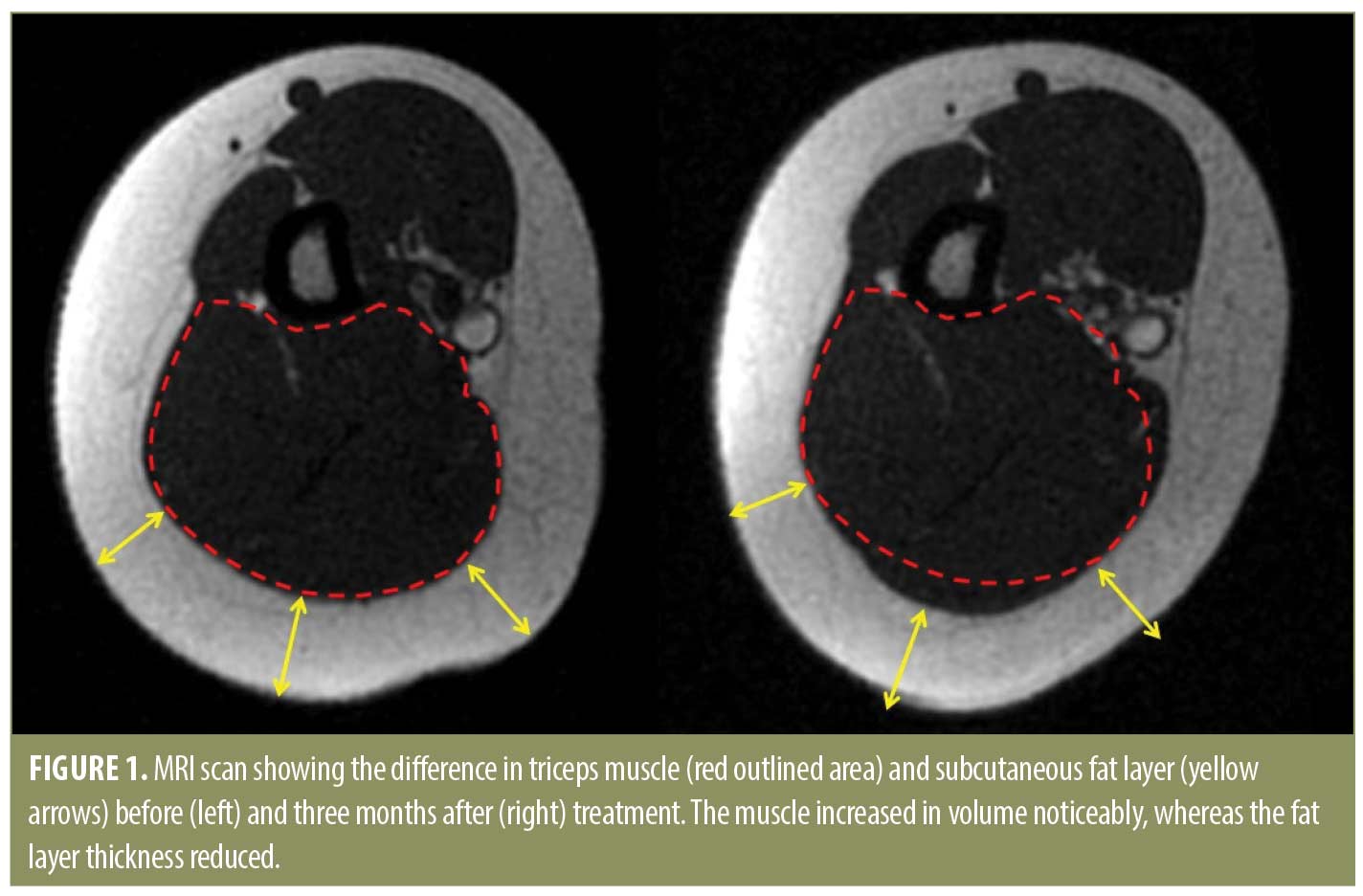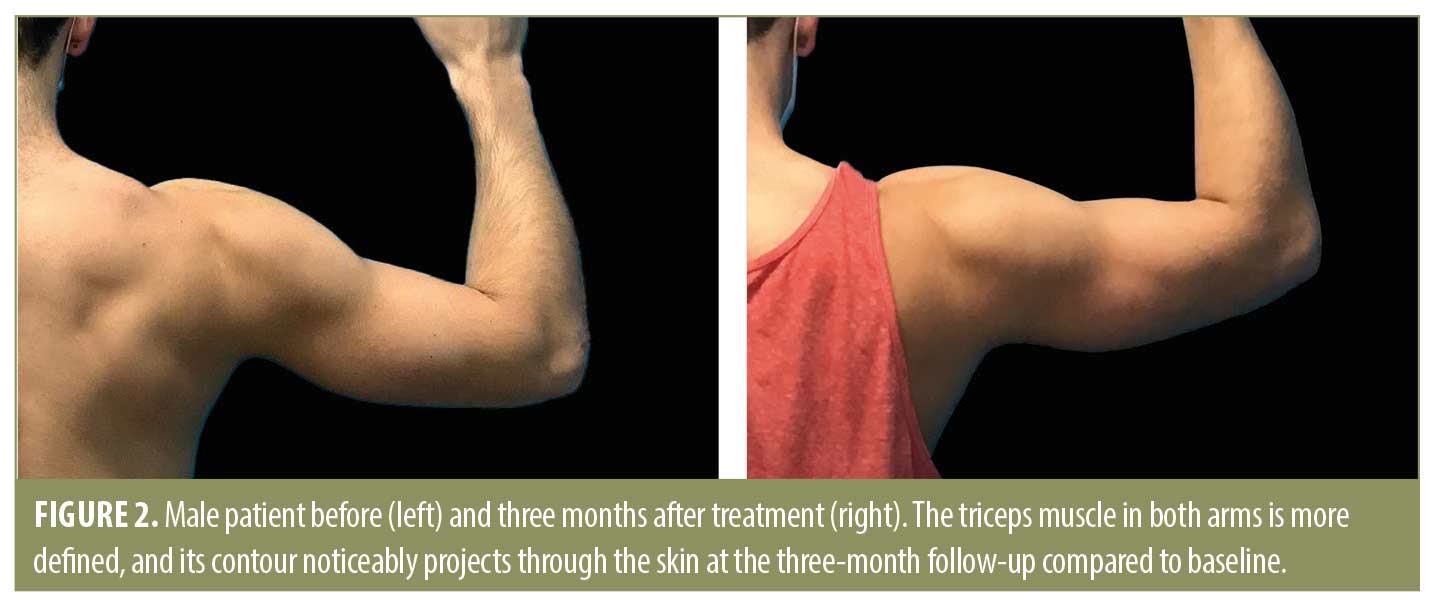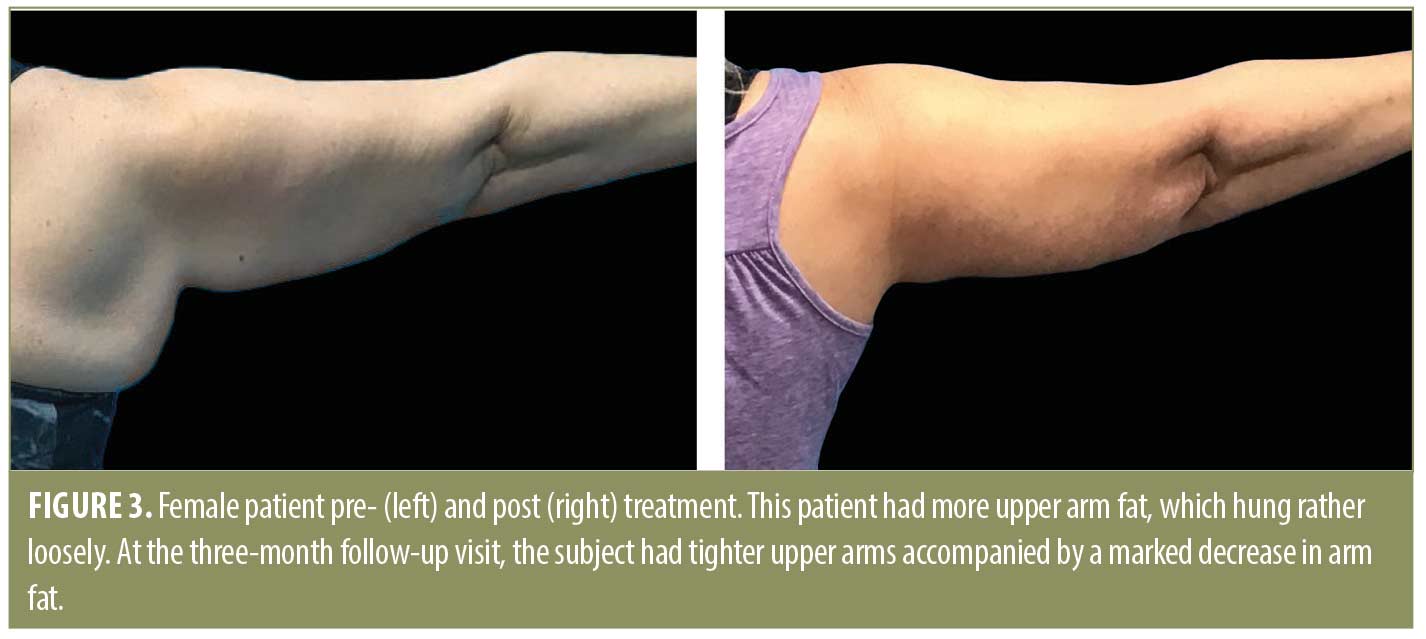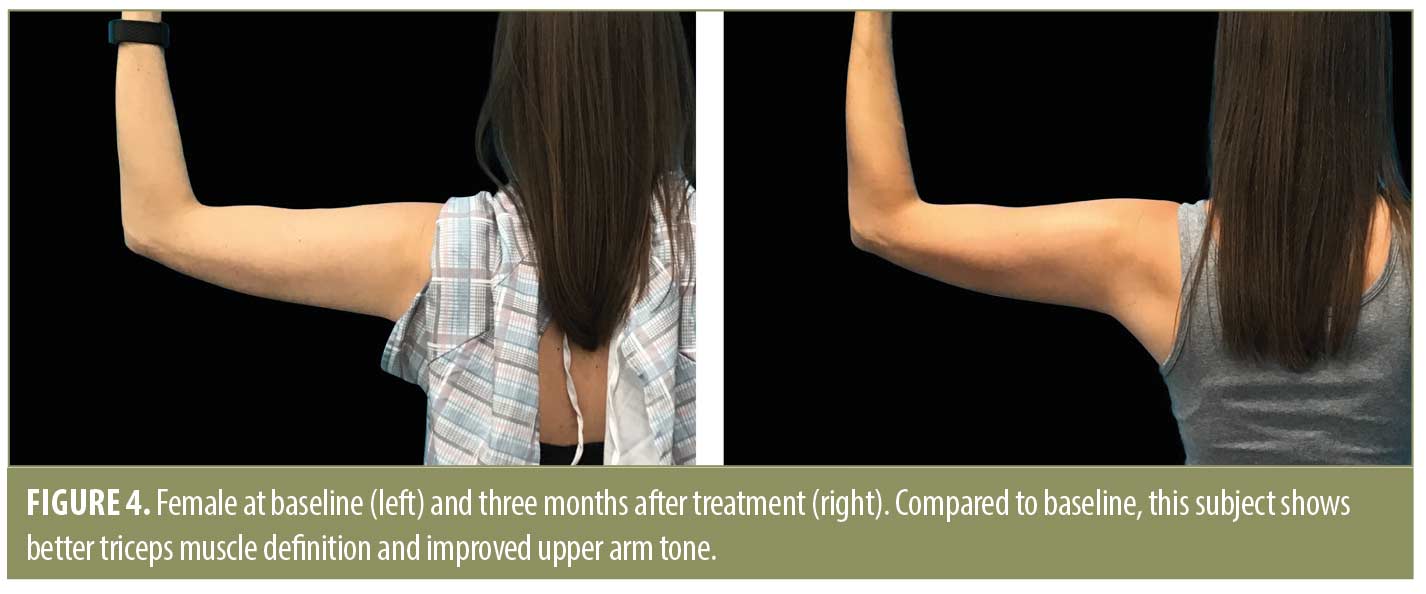 J Clin Aesthet Dermatol. 2023;16(2):50–54.
J Clin Aesthet Dermatol. 2023;16(2):50–54.
by Carolyn Jacob, MD and Robert A. Weiss, MD
Dr. Jacob is with Chicago Cosmetic and Dermatologic Research in Chicago, Illinois. Dr. Weiss is with Maryland Laser Skin and Vein Institute in Hunter Valley, Maryland
ABSTRACT: Objective. Several studies on the simultaneous use of high-intensity focused electromagnetic field (HIFEM) and radiofrequency (RF) have shown safety and effectiveness of fat reduction and muscle mass increases in other parts of the body. This study investigated HIFEM+RF procedure effect on muscle mass and adipose tissue in the upper arms.
Methods. Thirty-four subjects enrolled in this multicentric study underwent four, 30-minute bilateral procedures over the upper arms spaced one week apart, with the device simultaneously emitting HIFEM and RF energies. Fat and m. triceps muscle tissue change was measured via magnetic resonance imaging at baseline, 1-month, and 3-month follow-up visits. Additionally, digital photographs, patient comfort, and satisfaction questionnaires were obtained. The trial is registered on ClinicalTrials.gov under NCT04596241.
Results. MRI images analysis showed significant improvement at both follow-up visits. At 1-month follow-up (n=28) patients showed 22.3 percent (-4.0±1.2 mm) decrease of average fat tissue, and 21.5 percent (+8.2±2.3 mm) muscle mass increase. Twenty-five patients completed the 3-month follow-up visit, with average decrease in fat tissue by 25.5 percent (-4.9±1.5 mm) and average increase in muscle mass by 23.9 percent (+8.9±2.01 mm). Analysis of questionnaires revealed high satisfaction with the results (84.64%), high comfort during the treatment (91.18%), and low VAS score (1.58±2.0), indicating painless procedure.
Conclusion. Presented results demonstrate the safety and effectiveness of the HIFEM+RF procedure for muscle mass increase and fat reduction in the upper arm area. These findings correspond with the outcomes seen in other body parts.
Keywords: Arm, fat reduction, HIFEM, radiofrequency, triceps muscle
The upper arm appearance and flabbiness play a major role in body image perception. Many patients are concerned about the appearance and shape of upper arm muscles and excess fat, with more than $70 million in expenditure on cosmetic upper arm-lifts in the US in 2020 alone.1-3 Many patients now request less invasive treatments with shorter recovery times and fewer drawbacks, as we strive to develop safe and more efficacious procedures.4-6 Unfortunately, exercise and resistance training are not always feasible or desired options for patients, requiring exertion and extensive time investment, with results limited by physical capability, diet, and lifestyle.7-9 On the other hand, fat tissue grafting and implant surgery are associated with risks including scarring, asymmetrical shape, emboli, hematoma, infection, and nerve damage.1,10
Application of simultaneous high-intensity focused electromagnetic procedure (HIFEM) and radiofrequency (RF) is a viable option for treating fat and muscles, the tissues that are essential to target when one desires to achieve ideal upper arm contour. The HIFEM modality generates a high-magnitude alternating electromagnetic field that depolarizes neuromuscular tissue, inducing brain-independent supramaximal muscle contractions. The ensuing effect of these contractions is muscle hyperplasia and hypertrophy.11,12 The radiofrequency component primarily affects the subcutaneous fat tissue by elevating its temperature above the normal level. When the temperature is raised to and maintained between the 42 to 45°C range, selective heating of adipocytes induces a natural apoptosis cascade, thus reducing local fat deposits in the treatment area.13, 14
The procedure combining HIFEM and RF has been researched before on the abdomen, thighs, and buttocks.15,16 However, this study aims to investigate the effect of simultaneous HIFEM and RF procedure for non-invasive fat reduction and muscle mass increases of the upper arm to verify and expand its use on yet another body area.
Methods
This study enrolled thirty-four subjects (23-72 years, average BMI 25.26±4.43kg/m2, Fitzpatrick skin phototypes II-VI) at two sites. Adult patients seeking aesthetic improvement of upper arms underwent four 30-minute bilateral treatments over the upper arms, once per week, with the Emsculpt Neo (BTL Industries Inc., Boston, Massachusetts) device delivering HIFEM and RF energies simultaneously through a single applicator. The applicators were positioned and affixed throughout the procedure below the arm, treating the triceps muscle and adjacent fat deposits. The radiofrequency energy intensity was initially set to maximum (100%) and the magnetic field power (0-100%) was adjusted according to the subject’s tolerability.
Selection criteria included those aged 21 years or older with a BMI less than or greater to 35 kg/m2, subjects willing to abstain from partaking in any treatments other than the study procedure, and willingness to maintain a regular diet and exercise regimen unchanged during the study. In addition, subjects with metal or electronic implants or other medical conditions that contraindicate electromagnetic fields and RF application, such as cardiovascular disease, malignant tumor, or pregnancy were excluded from the study. Women of childbearing potential were required to use birth control measures during the study. This prospective, open-label, single-arm, non-randomized study was approved by the Advarra Institutional Review Board and followed the ethical guidelines of the 1975 Declaration of Helsinki. Informed consent was obtained from the subjects. This clinical study is registered on clinicaltrials.gov (NCT04596241).
The effect of simultaneous HIFEM and RF on the underlying fat and muscle tissue was measured by magnetic resonance imaging (MRI; 1.5 Tesla, T1 FSE sequence, TR: 200 ms, TE: 15 ms, slice thickness 3 mm, slice spacing 4 mm, acquisition matrix 320×320) in the axial plane. Patients were scanned in the supine position. Linear thickness measurements of the musculus triceps muscle and adjacent adipose tissue layer were obtained at the level where the muscle had the greatest thickness. The measurements were done in scans obtained at baseline, 1-month, and 3-month follow-up visits. In addition, digital photographs were obtained before and after treatment and during follow-up visits to document the visual appearance of the treatment area. Patient’s satisfaction with the treatment was assessed via a five-point Likert scale Subject Satisfaction Questionnaire after the last treatment and at each follow-up visit. Subjects filled out a Therapy Comfort Questionnaire consisting of a five-point Likert scale and visual analog scale (VAS) after each treatment. Throughout the study, potential adverse events and side effects were closely monitored.
The statistical analysis was performed using the Real Statistics Resource Pack software for Microsoft Excel. The paired differences between the values of individual subjects were tested by using One Factor ANOVA Repeated Measures ANOVA followed by Tukey HSD post-hoc test. The significance level α was set at five percent for all statistical tests.
Results
Thirty-one out of 34 patients completed all treatments while showing no significant change in weight or BMI throughout the study. The following Fitzpatrick Skin phototypes were represented: Type II (n=8),Type III (n=14), Type IV (n=5), Type V (n=5), and Type VI (n=2).
Based on the evaluation of obtained MRI scans, the overall thickness of m. triceps muscle increased significantly at 1-month and 3-month follow-up visits by +21.47 percent (+ 8.16 mm, p<0.001, N=28) and +23.89 percent (+ 8.89 mm, p<0.001, N=26) respectively. The difference in muscle thickness between the 1- and 3- months follow-up visits was also significant (p<0.05).
The fat layer thickness decreased at the 1-month and 3-month posttreatment visits. The results at both follow-up visits were significant, showing p-values<0.001, averaging -22.34 percent (-4.05 mm) and -25.50 percent (-4.86 mm) at one and three months, respectively. Moreover, fat layer reduction was also significant at 1-month and 3-month follow-up visits (p<0.01). A detailed summary of the MRI results can be found in Table 1. The representative changes in fat and muscle tissue seen in MRI are depicted in Figure 1. Furthermore, Figures 2 to 4 show illustrative changes in visual appearance captured by the digital photographs.





According to the subject satisfaction questionnaire, consisting of four criteria, over 87 percent of subjects were satisfied with the final outcome, more than 77 percent of the patients noticed toning of the upper arm and favorable improvement in both muscle and fat in the treatment area. Evaluation of the therapy comfort questionnaire showed that the treatment was essentially painless (1.6±2.0 on the VAS), and 91 percent of the subjects agreed that the treatment was comfortable according to the 5-point Likert scale. No serious adverse event related to the treatment procedure was noted in the short- (immediately after the treatments) and long-term (at follow-ups).
Discussion
Self-esteem is linked to body image, as women and men are concerned with achieving ideal body types related to feminine and masculine characteristics.9,17-21 This study highlighted the effects of treatments with simultaneous HIFEM and synchronized RF energies on the upper arm, the appearance of which is a common cause for concern. Outcomes showed a statistically significant reduction in subcutaneous fat and increased triceps brachii muscle thickness. Improvement in fat layer and muscle thickness was most prominent at the 3-month follow-up visit.
Changes documented in this study showed a remarkable increase in triceps muscle thickness (on average +21.47±2.97% and +23.89±3.78% at 1- and 3-month follow-up visits, respectively) accompanied by a concurrent fat reduction in the treated area. Posterolateral under-arm fat, colloquially referred to as “bat wings,” is a common result of excess fat accumulation in the body and is a major target of fat removal procedures.22-24 In our study subjects, MRI measurement showed decreased thickness of subcutaneous fat overlying m. triceps by -22.34±2.02 percent and -25.50±3.26 percent one and three months after the final treatment, respectively. In comparison, a previous study by Katz and Duncan25 documented +13.66 percent and +15.18 percent triceps muscle thickness increase in the subjects at one-month and three-month posttreatment ultrasound evaluations when researching the effects of HIFEM only treatments on the upper arms.25 Similar results were also achieved earlier in two HIFEM-treated cases showing +9.4-11.2 percent triceps brachii muscle increase.26
Based on the findings evidenced when only a single-modality approach was used, the addition of the synchronized RF to the HIFEM adds to results at corresponding follow-ups. Effects of combined HIFEM+RF treatment on fat and muscle tissue have been demonstrated before in human and animal studies.13-15 HIFEM modality primarily targets the muscle tissue by stimulating muscle fibers to increase in both number and size. This leads to overall growth of muscle tissue in density and volume, resulting in a more toned and defined appearance.27 Moreover, muscle contraction results in partial depletion of energy stored in adipocytes in the form of lipids. As the muscle tissue requires energy for metabolic processes, adipocytes release free fatty acids to produce energy in the form of ATP (adenosine triphosphate) to fuel the muscle demand. In addition, when elevated and maintained at a specific temperature range between 42 to 45°C, the radiofrequency heat induces subcutaneous fat apoptosis, consequently leading to decreased fat thickness.11,12 As the fat layer underlying the skin reduces, the thickened muscles become more clearly defined, contributing to an improved aesthetic appearance.
The investigated device utilizes both technologies in a curved-shaped applicator designed to comfortably reach localized body areas such as the upper arm. This is of great advantage, for example, when compared to traditional forms of body sculpting and shaping. Exercise and resistance training are limited by maximal voluntary muscle contractions and range of motion. Additionally, joints in the lower and upper arm—elbow, shoulder and wrist, which are composed of structures prone to mechanical and frictional damage may be involved.28-30
In this study, no serious adverse events occurred. There were no muscle spasms or skin quality deterioration in the treatment area. Subjects reported a high satisfaction level with the treatment results (87%), while at the same time, they found the procedure comfortable. This is a major advantage of the HIFEM+RF procedure since other popular upper arm contouring and shaping methods are associated with multiple risks or complications. For instance, arm-lift surgery (i.e., brachioplasty) may potentially result in hematoma, infection, aberrant scarring, wound dehiscence, and nerve damage. Furthermore, solid silicone implantation comes with the risk of implant extrusion or asymmetry (requiring corrective surgery), bleeding, seroma, and neuronal complications. Also, some non-invasive procedures like cryolipolysis, which targets subcutaneous fat by the temperatures below or near freezing point, may cause temporary numbness.1,4,6,10,31
Aside from the aesthetic benefits, the treatments may potentially be used as a form of physical exercise for strengthening the arms, particularly in elderly patients, to improve functionality. Geriatric women especially are more affected by loss of muscle mass and strength (i.e., dynapenia).32 As such, patients are prone to injury due to the increased incidence of falls, and are predisposed to metabolic disorders including Type II diabetes and sarcopenia.33 Moreover, the device offers an alternative for patients with reduced range of motion or difficult mobility, since access and ability to manipulate resistance training equipment may be complicated and inconvenient due to limited range of joint movement or pain.34-36 Thus, improved arm strength may counter frailty, a major sign of aging, improve physical fitness and also increase the quality of life in the elderly.37 Future studies should investigate improvements in strength following HIFEM and RF treatments.
This study’s major strengths are objective evaluation of studied outcomes by the MRI assessment in the entire patient group followed for three months after treatment. To improve the study design in future, perhaps a control arm could be included to identify and exclude the possible placebo effect and even compare the study treatment with other available technologies. In addition, future studies may investigate not only the triceps but also the biceps muscle analogously to the methods we used in this study.
Conclusion
The procedure combining simultaneous HIFEM and RF energies demonstrated improvement in excess adiposity in the upper arm along with shaping and toning of the triceps muscle. The procedure is comfortable with highly satisfactory outcomes and results that gradually improve up to three months after the delivery of the last treatment with less risks than other modalities.
References
- Miotto G, Ortiz-Pomales Y. Arm Contouring: Review and Current Concepts. Aesthetic Surgery Journal. 2018;38(8):850–860.
- 2020 Plastic Surgery Statistics Report. PLASTIC SURGERY. Published online 2020:26.
- Sarwer DB, Polonsky HM. Body Image and Body Contouring Procedures: Table 1. Aesthet Surg J. 2016;36(9):1039–1047.
- Mazzoni D, Lin MJ, Dubin DP, et al. Review of non-invasive body contouring devices for fat reduction, skin tightening and muscle definition. Australas J Dermatol. 2019;60(4):278–283.
- Rivers JK, Ulmer M, Vestvik B, et al. A customized approach for arm fat reduction using cryolipolysis. Lasers Surg Med. 2018;50(7):732–737.
- Shirvani A, Palermo NE, Holick MF. Man of Steel Syndrome: Silicone and Mineral Oil Injections With Associated Hypercalcemia, Hypophosphatemia, and Proximal Muscle Weakness. JBMR Plus. 2019;3(10):e10208.
- Schoenfeld BJ, Grgic J, Krieger J. How many times per week should a muscle be trained to maximize muscle hypertrophy? A systematic review and meta-analysis of studies examining the effects of resistance training frequency. J Sports Sci. 2019;37(11):1286–1295.
- Alves RC, Prestes J, Enes A, et al. Training Programs Designed for Muscle Hypertrophy in Bodybuilders: A Narrative Review. Sports (Basel). 2020;8(11):E149.
- Nissen NK, Holm L. Literature review: perceptions and management of body size among normal weight and moderately overweight people. Obes Rev. 2015;16(2):150–160.
- Sisti A, Cuomo R, Milonia L, et al. Complications associated with brachioplasty: a literature review. Acta Biomed. 2017;88(4):393–402.
- Duncan D, Dinev I. Noninvasive Induction of Muscle Fiber Hypertrophy and Hyperplasia: Effects of High-Intensity Focused Electromagnetic Field Evaluated in an In-Vivo Porcine Model: A Pilot Study. Aesthet Surg J. 2020;40(5):568–574.
- Halaas Y, Duncan D, Bernardy J,et al. Activation of Skeletal Muscle Satellite Cells by a Device Simultaneously Applying High-Intensity Focused Electromagnetic Technology and Novel RF Technology: Fluorescent Microscopy Facilitated Detection of NCAM/CD56. Aesthetic Surgery Journal. 2021;41(7):NP939–NP947.
- Weiss RA, Bernardy J, Tichy F. Simultaneous Application of High-Intensity Focused Electromagnetic and Synchronized Radiofrequency for Fat Disruption: Histological and Electron Microscopy Porcine Model Study. Dermatol Surg. 2021 Aug 1;47(8):1059-1064.
- Goldberg DJ. Deletion of adipocytes induced by a novel device simultaneously delivering synchronized radiofrequency and HIFEM: Human histological study. J Cosmet Dermatol. 2021;20(4):1104–1109.
- Jacob C, Kent D, Ibrahim O. Efficacy and Safety of Simultaneous Application of HIFEM and Synchronized Radiofrequency for Abdominal Fat Reduction and Muscle Toning: A Multicenter Magnetic Resonance Imaging Evaluation Study. Dermatol Surg. 2021;47(7):969–973.
- Duncan DI. Combination treatment for buttock and abdominal remodeling and skin improvement using HIFEM procedure and simultaneous delivery of radiofrequency and targeted pressure energy. Journal of Cosmetic Dermatology. 2021;20(12):3893–3898.
- Sarwer DB. Body image, cosmetic surgery, and minimally invasive treatments. Body Image. 2019;31:302–308.
- Toselli S, Spiga F. Sport practice, physical structure, and body image among university students. J Eat Disord. 2017;5(1):31.
- Palmer K, Bschaden A, Stroebele-Benschop N. Changes in lifestyle, diet, and body weight during the first COVID 19 “lockdown” in a student sample. Appetite. 2021;167:105638.
- Bouzas C, Bibiloni MDM, Julibert A, et al. Adherence to the Mediterranean Lifestyle and Desired Body Weight Loss in a Mediterranean Adult Population with Overweight: A PREDIMED-Plus Study. Nutrients. 2020;12(7):E2114.
- Bouzas C, Bibiloni MDM, Tur JA. Relationship between Body Image and Body Weight Control in Overweight ≥55-Year-Old Adults: A Systematic Review. Int J Environ Res Public Health. 2019;16(9):E1622.
- Gu Y, Kang N, Lv Q, et al. Application of a Proposed Multi-Positional Circumferential Arm Liposuction Method and Quantification of its Clinical Efficacy Evaluation. Aesthetic Plast Surg. 2021;45(3):1115–1124.
- Scotto di Palumbo A, Guerra E, Orlandi C, et al. Effect of combined resistance and endurance exercise training on regional fat loss. J Sports Med Phys Fitness. 2017;57(6):794–801.
- Paoli A, Casolo A, Saoncella M, et al. Effect of an Endurance and Strength Mixed Circuit Training on Regional Fat Thickness: The Quest for the “Spot Reduction.” Int J Environ Res Public Health. 2021;18(7):3845.
- Katz B, Duncan D. Lifting and Toning of Arms and Calves Using High-Intensity Focused Electromagnetic Field (HIFEM) Procedure Documented by Ultrasound Assessment. J Drugs Dermatol. 2021;20(7):755–759.
- Katz B. MRI Assessment of Arm and Calf Muscle Toning With High-Intensity Focused Electromagnetic Technology: Case Study. JDD. 2020;19(5):556–558.
- Duncan D, Chilukuri S, Kent D, et al. Non-Invasive Alternatives for Liposuction. IntechOpen. 2022.
- Avelar A, Ribeiro AS, Nunes JP, et al. Effects of order of resistance training exercises on muscle hypertrophy in young adult men. Appl Physiol Nutr Metab. 2019;44(4):420–424.
- Kholinne E, Zulkarnain RF, Sun YC, et al. The different role of each head of the triceps brachii muscle in elbow extension. Acta Orthop Traumatol Turc. 2018;52(3):201–205.
- Alves D, Matta T, Oliveira L. Effect of shoulder position on triceps brachii heads activity in dumbbell elbow extension exercises. J Sports Med Phys Fitness. 2018;58(9):1247–1252.
- Chugay N, Chugay P, Shiffman M. Triceps Augmentation. In:2014:55–79.
- Neves T, Ferriolli E, Lopes MBM, et al. Prevalence and factors associated with sarcopenia and dynapenia in elderly people. J Frailty Sarcopenia Falls. 2018;3(4):194–202.
- Cannataro R, Carbone L, Petro JL, et al. Sarcopenia: Etiology, Nutritional Approaches, and miRNAs. International Journal of Molecular Sciences. 2021;22(18):9724.
- Sousa N, Mendes R, Monteiro G, et al. Progressive resistance strength training and the related injuries in older adults: the susceptibility of the shoulder. Aging Clin Exp Res. 2014;26(3):235–240.
- Gill TK, Shanahan EM, Tucker GR. Shoulder range of movement in the general population: age and gender stratified normative data using a community-based cohort. BMC Musculoskelet Disord. 2020;21(1):676.
- Legg HS, Arnold CM, Trask C. Does functional performance and upper body strength predict upper extremity reaction and movement time in older women? Human Movement Science. 2021;77:102796.
- Angulo J, El Assar M, Álvarez-Bustos A, et al. Physical activity and exercise: Strategies to manage frailty. Redox Biol. 2020;35:101513.

